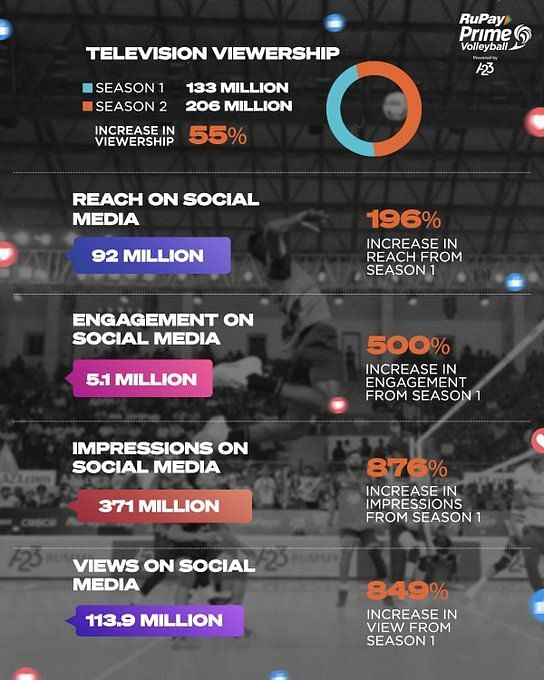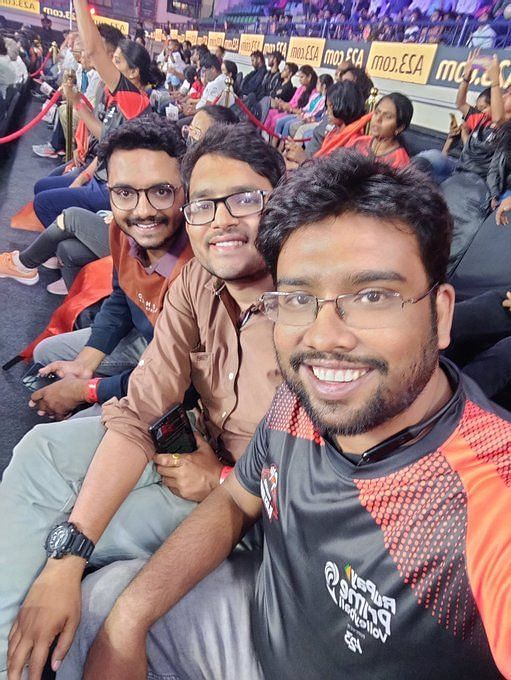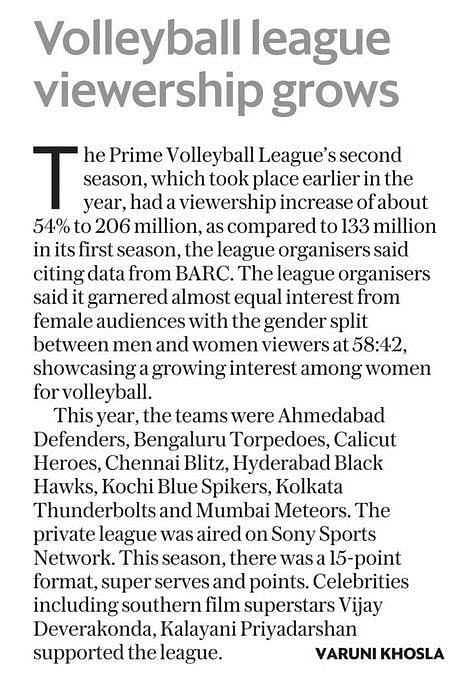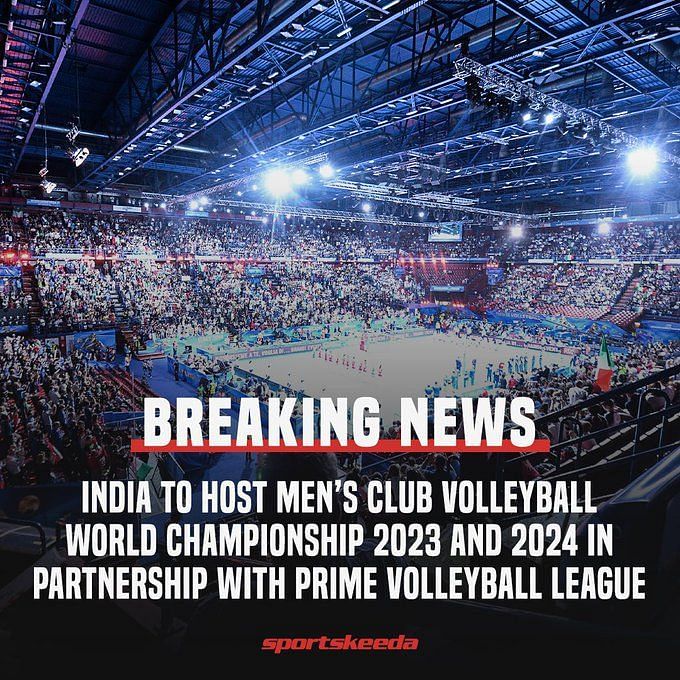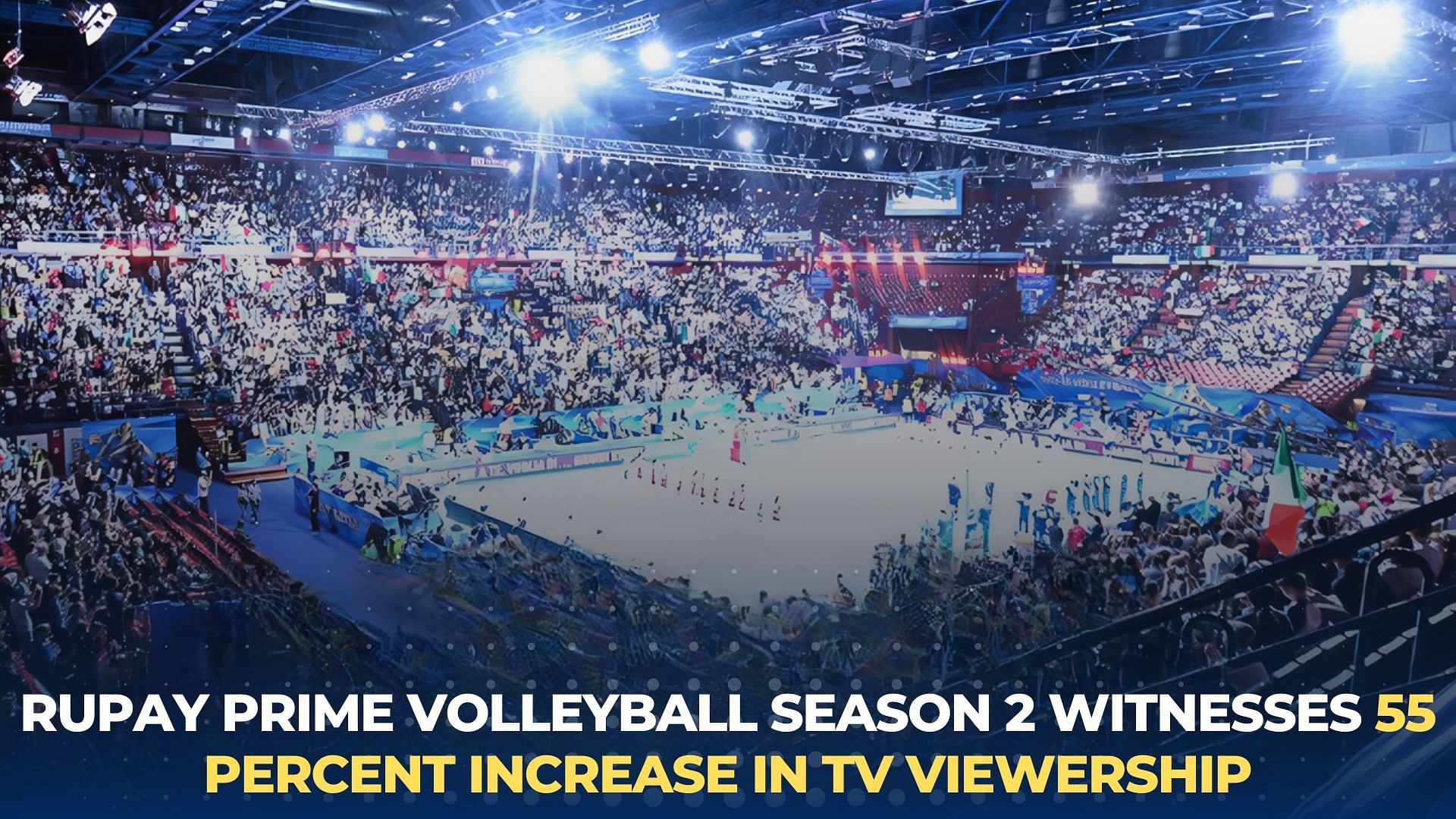
With an astounding TV viewership of 206 million, Prime Volleyball shows how a privately run league can be successful
India's very first private Volleyball league is the RuPay Prime Volleyball League, boasting franchises from eight different Indian cities. As such, they are the Mumbai Meteors, Kochi Blue Spikers, Kolkata Thunderbolts, Bengaluru Torpedoes, Chennai Blitz, Hyderabad Black Hawks, and Ahmedabad Defenders. In the Indian subcontinent, the league is aired on Sony LIV and the Sony Sports Network, while Volleyball World TV broadcasts the tournament across the world.
All of the best foreign and Indian volleyball players compete in the league. With season 2 of the Rupay Prime Volleyball League kicking off on February 4 and ending on March 5, the tournament was a huge success. According to The Hindustan Times, the tournament saw a 500 percent increase in engagement compared to season 1, with a viewership of around 113.9 million this year.
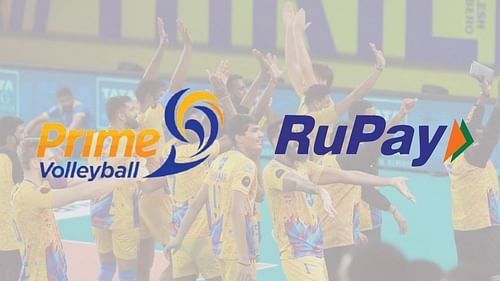
Sportskeeda got an exciting opportunity to have a conversation with Mr. Joy Bhattacharjya, CEO of PVL, and Mr. Tuhin Mishra, Managing Director of Baseline Ventures and co-founder of PVL, both of whom discussed the success of PVL Season 2 and what led to such a significant increase in the overall digital stats of the league.
Speaking about PVL with Mr Joy Bhattacharjya, CEO of RuPay Prime Volleyball League, and Mr Tuhin Mishra, Managing Director of Baseline Ventures and Co-Founder of RuPay Prime Volleyball League
Q1. The RuPay Prime Volleyball League witnessed a remarkable 55 percent increase in TV viewership for Season 2. Can you provide some insights into the factors that contributed to this unprecedented success, such as the format of the league, the presence of celebrities, and the strategies employed by the organizers?
A: There are many reasons for the unprecedented success of our league. This extra 55%, if you break it down, it comes from the very start. First, with the marketing campaign, we said we wanted to prove to people that we felt the insight was that everyone had played volleyball, but they didn't know how well it could be played or how exciting it could look.
So, we introduced them to volleyball as a game they had played and then showed them how this volleyball was totally different. We did it in many languages, and that went out very early. And that was our first communication.
The second thing was that we were on the ground in three key cities and most of our advertising spending was focused on the South, where we felt there was a great deal of intake for volleyball and the interest was already there.
It's what we call an already fertile territory. I think we did a great job of managing to convert a lot of people out there. The third thing that happened was the fact that actual on-ground events always create excitement in the city. They always create buzz and I think in Bangalore and Hyderabad this time around, it really made a difference with the fans and no COVID-19 around.
And of course, Kochi was even better than the rest in terms of the sheer excitement that we had. So, in all those ways, I think we got the mix properly. The product was excellent, and the quality of the volleyball was already good.
I think it got even better as the teams understood each other and I think that's where we've got a product. It was placed well. In the right place, we got the right product and we pushed it well. The positioning was right, that this is volleyball, the iconic family game showcased in a very good, exciting new format.
Q2. Season 2 of the RuPay Prime Volleyball League featured a range of innovative features, such as Super Serves and Super Points, as well as star-studded teams with cinestars and sports personalities. How did these elements create an engaging and thrilling viewing experience for fans, and what kind of impact did they have on the overall popularity of volleyball in India?
A: Our league, ever since its inception, has introduced a few things which have made the viewing experience, both on the ground as well from homes, very interesting. With concepts like Super Point and Super Serve, each match is played for 15 points instead of the traditional 25 points.
These novel concepts have made audiences lap up the game of volleyball even more. Plus, there are a lot of strategies that every team has to deploy in every set. Not only have these concepts gone down well in India, but we have received positive feedback, even from the global body of volleyball.
The head coach of the US Volleyball team has gone on record to say that these new concepts introduced by PVL are the way forward for volleyball globally. The impact can already be seen amongst kids who have now started playing volleyball in India using the concepts of Super Point and Super Serve.
Q3. It is noteworthy that the RuPay Prime Volleyball League managed to attract almost equal interest from female audiences, with a 42 percent viewership share. What do you think are the reasons behind this trend, and how might it impact the future of women's volleyball in India and beyond?
A: RuPay Prime Volleyball has created a sensation in terms of a huge following of the sport amongst female audiences. One of the main reasons is that the sport is very easy to follow. A lot of women have played this sport in school, colleges, or even with their families at beaches/vacations etc.
Our volleyball players, including the foreign ones, might probably be the most athletic and good-looking bunch of athletes who play this sport. Which sport in India can have such a visual spectacle that, on average, you get to see 6’4 or 6’5 tall hunks jumping almost 25-30 inches in the air and smashing the balls? It’s a visual delight.
Later down the line, PVL will also introduce the Women’s League once we feel we have a good pool strength of at least 70-80 Indian female volleyball players for teams to choose from.
Q4. The success of Season 2 of the RuPay Prime Volleyball League extended beyond India, with a global viewership on Volleyball World TV and interest from countries such as the UAE, USA, and Canada. What kind of impact did the league have on the global volleyball community, and what does this mean for the future of the sport on an international level?
A: Rupay Prime Volleyball League saw audiences from at least 40 to 50 countries from around the world, where the league was really appreciated. In terms of the people who watched this league, they felt that it had been played at the highest possible level.
The television production quality got unanimous feedback from everyone and a lot of people wrote us emails and sent us messages, stating that the league's television and on-ground production was probably one of the best in the world in the sport of volleyball. That's a huge plus for the league.
Even the top management of the global body of volleyball, FIVB, which is based out of Switzerland, had come down to witness our league during the semifinals and finals in Kochi, and they were thoroughly impressed with what they saw, and have extended all of their support to PVL. That's why we've got into a long-term partnership with Volleyball World, the commercial arm of FIVB, through which all of our matches are streamed live across their OTT platform known as Volleyball World TV.
We also feel that going forward we'll be doing a lot of stuff or we'll be working very closely with the global body so that we can promote the sport of volleyball.
All of this has happened only because they have seen the level of the league in terms of television production, sponsorship, and on-ground management. This eventually resulted in the global body of volleyball, FIVB and Volleyball World, giving us the rights to host the World Club Championship in India later this year.
I think the way that PVL has been conducted is one of the major reasons as to why we got the rights to host it in India for the very first time, where the top six clubs will participate. So, the winning team of Season 2, which is the Ahmedabad Defenders of Prime Volleyball League, and the top five clubs from around the world will be playing in India between December 6 and December 10 this year. Basically, the Ahmedabad defenders will be playing against these top clubs from Latin America, North America, Europe, and Africa.
I think that's a huge impetus that the sport of volleyball will get in our nation. This is all thanks to what has happened globally and what the global trade or the global body of volleyball has seen in the impact that has been created by PVL in India.
Q5. As India's only private sports league, the RuPay Prime Volleyball League has played a significant role in the growth of the sports industry in the country. What are the future plans for the league, and how do you see it contributing to the development of volleyball and other sports in India? Additionally, how might the success of the league inspire other private organizations to invest in sports and promote a culture of sportsmanship in the country?
A: I think RuPay Prime Volleyball League has already become a case study in India and the nation's sports industry. How the operations of a sporting league, which is completely private, can be run successfully in India because what we have done is we've created a model where every team is also an owner of the league.
This kind of model doesn't exist in India. Whether you look at any of the other leagues, whether it's in cricket, kabaddi, or football. Globally, yes, this kind of concept has been very successful and we've all felt as a team that if such a system can exist and run successfully in other parts of the world, whether it's the NBA or Major League Soccer or even EPL, why can't it happen in India as well? From my experience, we have all seen it before.
When we've seen different leagues, we all feel that when every team has skin in the game, which is in terms of being owners of the league, then every team is not just a team owner who isn't just thinking about his team but is also thinking about the league.
That's one point. Secondly, what has happened is that when you have such a collaborative approach, then every team or team owner also thinks about bringing the best practices to ensure that the league moves forward in the right direction, and that's what's happening with RuPay Prime Volleyball League over the last two years. We are very thankful that we've got some great owners who have come on board and are contributing immensely.
It was the success of the league and I think we have already created a blueprint for other leagues who are looking into, in terms of developing a league in a private space or a completely 100% private space, how a certain business model can be performed.
How a business model can be successfully implemented as well because the most important thing when you're running a league is that you need to make it viable for every investor and every participant. As RuPay Prime Volleyball League is one of the founders of the Ruby Prime Volleyball League, this has been our focus right from day one.
What we also want to do is that once people see this, it will inspire a lot of other organizations. It will inspire individuals to work towards this goal, and if, at the end of the day, when leagues are successful, it brings about a positive change in the entire ecosystem of that sport, we sincerely hope that we're able to do that through our Prime Volleyball League.
